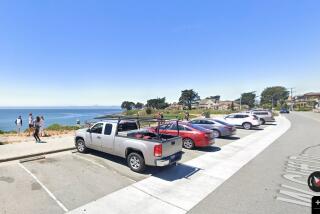Woman Killed in Shark Attack
AVILA BEACH, Calif. — A 50-year-old woman died when a shark attacked her as she swam with seals Tuesday morning near the pier of this tiny beach town near San Luis Obispo, authorities said.
Deborah Franzman of Nipomo, Calif., was swimming as she did several times a week near some buoys about 75 yards offshore when the rare attack occurred about 8:20 a.m.
“The water was full of blood,” said Antonio Neotti, 15, an aspiring lifeguard who watched four lifeguards swim through the surf to rescue her.
“They pulled her out on the beach,” he said. “She was not conscious. It looked like she was bitten in her hip and her upper thigh.”
A friend watching Franzman from onshore said that harbor seals suddenly scattered and that the swimmer was engulfed in a large breach of white water, according to state and local authorities.
A man near the beach reported seeing a large fin.
Franzman, a sociology instructor at Allan Hancock College in Santa Maria, died at the scene.
Lifeguards immediately closed the waters to swimming.
“The picture painted so far fits perfectly of what would be a white shark incident,” said Robert Lea, a marine biologist who tracks shark attacks for the California Department of Fish and Game. “We’ll know more after the autopsy. But if you look at the statistics, most incidents are at the surface. These animals are ambush predators. They come up from underneath.”
If confirmed by the autopsy planned for today, Franzman’s death would be the 10th shark-bite fatality in California waters since authorities standardized record-keeping in the early 1950s.
Not only are unprovoked shark bites unusual -- with 93 reported since the record-keeping began -- biologists believe that they often may be due to mistaken identity.
In this case, they suspect that Franzman, who was clad in a dark wetsuit and fins, resembled the seals that are abundant in the waters off Avila Beach and adjacent Port San Luis. Seals are the favorite food of mature great white sharks.
“There’s a common denominator here,” Lea said. “She’s swimming with marine mammals. If you are a swimmer on the surface, you have a silhouette that looks like a marine mammal.”
Most shark-bite victims survive if they can make it ashore quickly and stop the hemorrhaging. In this case, coroner’s officials suspect that the woman bled to death because the shark appeared to have severed the femoral artery.
“We should be able to determine the cause of death,” said Capt. Gary L. Hoving of the San Luis Obispo County Sheriff’s Department. “We’ll find out if it was drowning or loss of blood.”
At the request of state fish and game officials, the coroner’s office will also X-ray the wounds to look for tooth fragments and scratch marks on the bone to determine if the bites came from a great white shark. Great whites are protected under state law and are known to hunt in the coastal waters off Northern and Central California.
Franzman, who was following her regular routine, arrived at the beach with a friend and two dogs, and swam along offshore buoys that mark the beach west of the pier as restricted from motorboats.
Authorities estimate it to be about 15 feet deep.
Lifeguards normally do not come on duty until 10 a.m. But about 25 guards were congregated at Avila Beach for a regional competition, including swimming around the pier. Some guards were in the water at the time of the attack.
Neotti was on the pier, watching the competition, and noticed that the “seals seemed to be acting all funny. They were bunched up together and they would come up and look around.”
Then Franzman’s friend starting shouting for help from shore and lifeguards were soon sprinting down the beach to come to Franzman’s aid. Four of them plunged into the water and swam out to help her.
“They were just acting on training and instinct, without thinking about any potential danger [for themselves],” said Russ Edwards, senior lifeguard for the Port San Luis Harbor District. “There is no guideline in the U.S. Lifeguard Assn. manual which specifies we have to go into the water and make a rescue in a situation like this.”
Greg Weisberg, head of the harbor district’s marine safety division, said the lifeguards “tried to administer first aid to the best of their ability.”
Avila Beach, which is 200 miles north of Los Angeles, is about 10 miles from the closest ambulance.
Paramedics from the California Division of Forestry were the first to arrive.
Authorities had to improvise.
San Luis Obispo County Sheriff’s Deputy Matt Danielson said the ambulance couldn’t cross the broad beach, so a lifeguard truck ferried Franzman to the street.
Lifeguards patrolled the beaches along the coast throughout the day and night to warn people to stay out of the surf.
A Coast Guard ship came into the sheltered bay and warned boaters of the danger.
The incident rattled authorities in this beach town, which is best known for the nearby Diablo Canyon nuclear power plant and the enormous underground oil spill that forced Unocal to raze most of downtown in its extensive cleanup efforts.
“Usually, we see very petty stuff, like drinking on the beach, parking violations and kids getting out of hand,” Danielson said. “We’ve never seen anything like this.”
Sheriff’s Lt. Martin Basti spent the day fielding questions from a swarm of television journalists drawn by the freak incident.
“The odds of this happening are just so incredible, it’s hard to know what to do,” Basti said.
More to Read
Sign up for Essential California
The most important California stories and recommendations in your inbox every morning.
You may occasionally receive promotional content from the Los Angeles Times.










